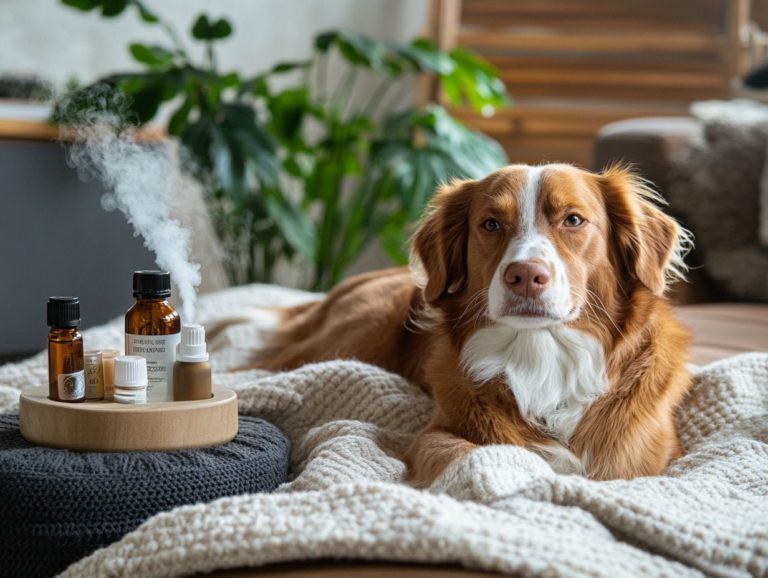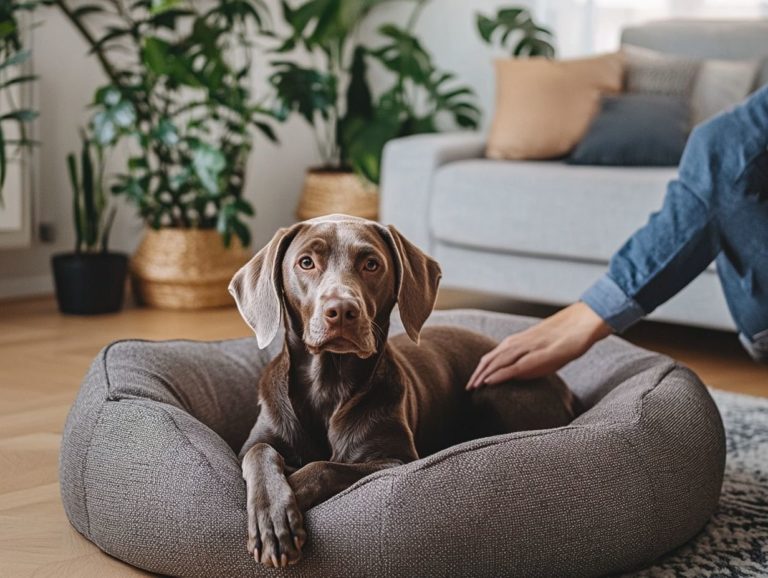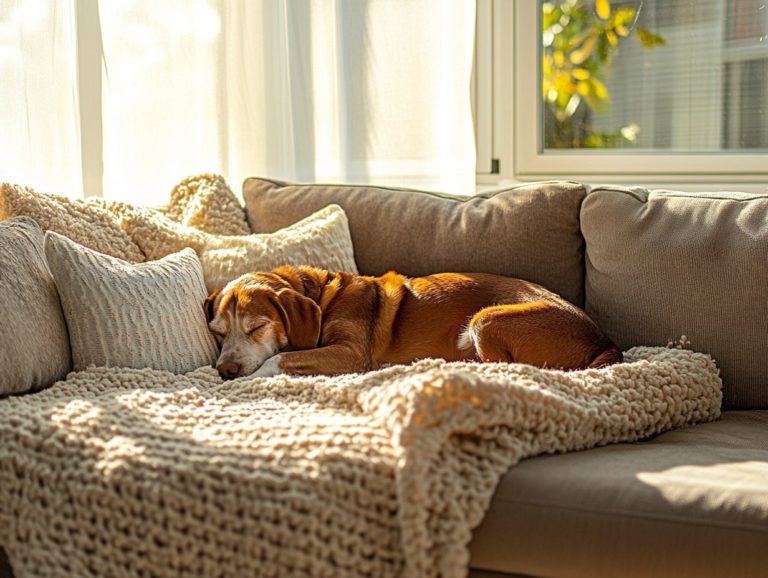How to Select a Calming Color Palette for Pets
Color shapes your pets’ environments and influences their mood and behavior. It s important for pet parents to recognize how powerful color can be.
Soothing tones like blues and greens create calm, while vibrant shades like yellows and pinks encourage playfulness. With the right colors, you can enhance your pet’s quality of life.
This article explores how to select colors that resonate with various animals, offers tips for crafting a tranquil space in shelters or homes, and provides practical advice for maintaining that serene atmosphere.
Discover how easy color choices can dramatically change the happiness of your furry friends! The right hues can even enhance customer perception of your pet’s environment.
Contents
- Key Takeaways:
- The Importance of Color in Pet Environments
- Choosing the Right Color Palette for Your Pet
- Calming Colors for Different Types of Pets
- Creating a Calming Space for Your Pet
- Tips for Maintaining a Calming Color Palette
- Frequently Asked Questions
- 1. How do I select a calming color palette for my pets?
- 2. What are some examples of calming colors for pets?
- 3. How can I incorporate calming colors into my pet’s environment?
- 4. Can certain colors have a negative effect on pets?
- 5. How can I tell if my pet is reacting positively to a calming color palette?
- 6. Are there any additional ways to create a calming environment for my pets?
Key Takeaways:

- Understanding the impact of color on pets’ mood and behavior is crucial for selecting a calming palette.
- Consider factors like species and personality when choosing colors for your pet’s space.
- Different pets respond uniquely to colors; choose calming hues tailored to their needs.
The Importance of Color in Pet Environments
Color holds immense significance in pet environments, profoundly affecting the emotional responses of both pets and their caregivers. Research, including the Babin study, underscores the psychological influence of color on humans and animals alike.
It is essential for shelters, veterinary practices, and pet owners to understand how to strategically use color to create an inviting atmosphere. A thoughtfully selected color palette promotes feelings of tranquility and cleanliness, while attracting potential adopters and enhancing the overall health and well-being of pets.
How Color Affects Pets’ Mood and Behavior
The influence of color on your pet’s mood and behavior can be quite significant, affecting everything from their anxiety levels to their playfulness, all depending on the colors in their environment.
For example, studies reveal that soothing colors like blues and greens can notably lower stress in dogs and cats, making them especially beneficial in veterinary clinics, where anxiety is often at its peak. In contrast, bright colors such as red and orange can spark excitement or even aggression hardly what you want in a space meant for relaxation.
By thoughtfully integrating these colors into waiting rooms and examination areas, veterinary professionals can foster a more supportive atmosphere. Research shows that pets, much like humans, respond differently to color, highlighting the necessity of customized colors that fit each pet s personality.
Choosing the Right Color Palette for Your Pet
Choosing the perfect color palette for your pet’s environment is crucial for fostering cleanliness, emotional well-being, and a comfortable home. The colors you opt for can significantly influence not only the mood and behavior of your pets but also how caregivers and potential adopters perceive them.
By recognizing how colors like blue, green, and earthy tones cultivate an atmosphere of tranquility, you can design a space that truly nurtures the health and happiness of your beloved companions.
Factors to Consider
When selecting a color palette for your pet’s environment, there are several critical factors to consider that will elevate their overall well-being and satisfaction.
For instance, different pets respond uniquely to various shades; a vibrant hue might spark joy in a playful dog, while softer pastels could provide comfort to a nervous cat. Understanding their emotional reactions to colors can greatly influence their mood and behavior. The cleanliness of the environment also matters significantly brighter colors can sometimes draw attention to dirt or mess, impacting caregivers perceptions of maintenance.
To create a harmonious space, think about incorporating colors that resonate with your pet s temperament (the natural mood and behavior of your pet) and natural instincts. For example, choose calming blues and greens for anxious pets, while more moderate, warming tones like yellows or oranges can invigorate active companions. This tailored approach not only enhances your pet’s comfort but also crafts a visually inviting setting for you as a caregiver, making your environment feel luxurious and welcoming.
Calming Colors for Different Types of Pets
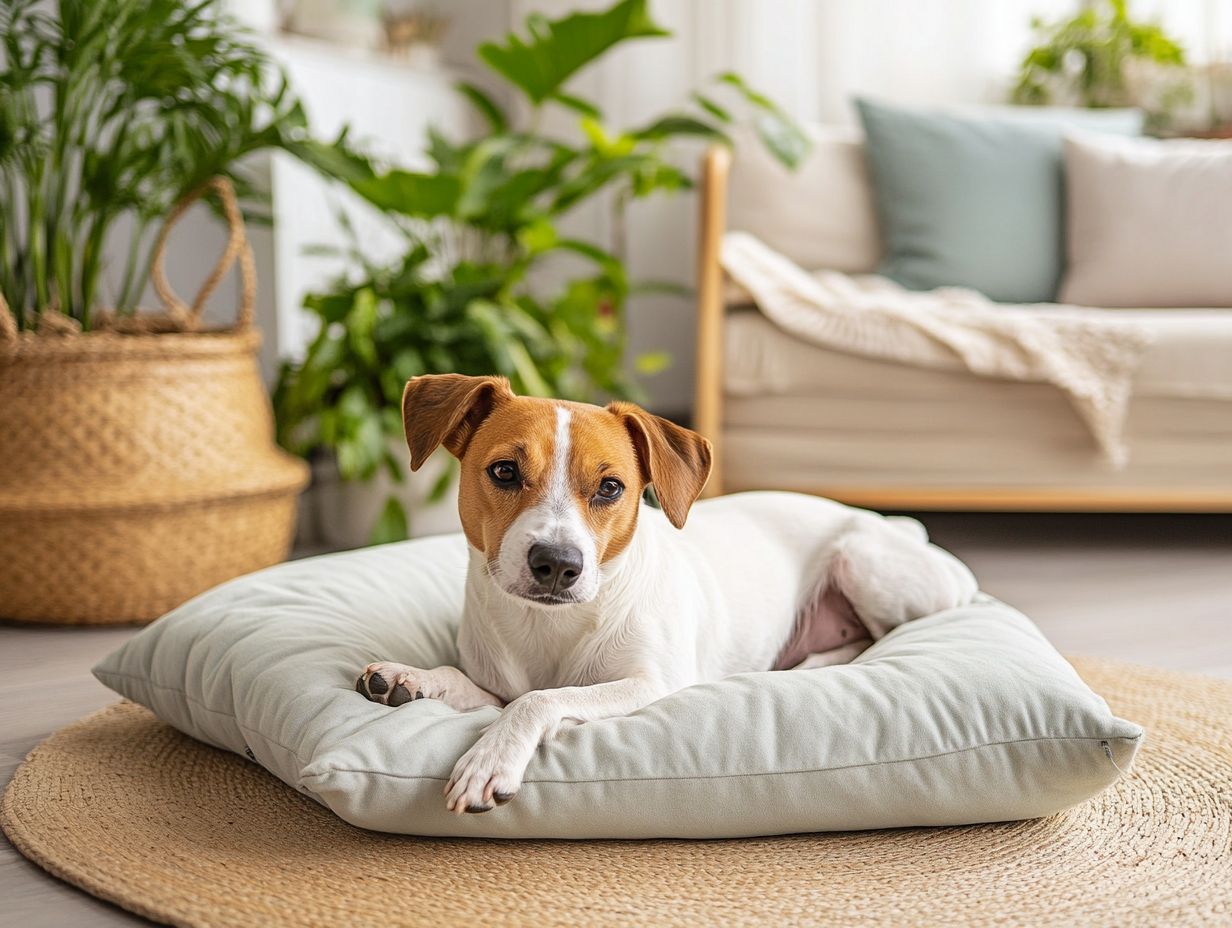
Different types of pets respond uniquely to various soothing shades, significantly influencing their emotional reactions and overall behavior. By understanding these responses, you can create serene environments that cater specifically to the needs of your dogs, cats, small animals, and birds.
For instance, your dog might find peace in hues of blue or green, while your cat may thrive in softer shades that exude a calming aura. Tailoring your space with these colors can enhance your pets well-being and create a harmonious atmosphere in your home.
Dogs
Dogs typically respond favorably to calming colors like blue and green, which create a calm and comfortable space.
These soothing hues have been proven to lower anxiety levels, enhancing the overall well-being of your canine companions. By incorporating these calming colors into various elements of their living spaces, including bedding and toys, you can create a significant positive impact on their emotional stability.
For instance, opt for bedding in soft blue or muted green tones to encourage relaxation during nap times. Soft toys and blankets adorned in these colors can offer comfort, especially during stressful moments like thunderstorms or when they re left alone.
By thoughtfully integrating these shades into their environment, you can cultivate a peaceful home for your dogs, ultimately leading to more relaxed and happier pets.
Cats
Cats flourish in spaces infused with calming colors, like soft blues and muted greens, which play a significant role in reducing stress and fostering relaxation.
These hues resonate with your cat’s intrinsic instincts, crafting a sanctuary that encourages serenity, inviting a sense of freshness into their environment. For instance, muted tones can help ease the anxiety of nervous cats, allowing their natural curiosity and exploratory behaviors to blossom.
When you consider introducing these colors into your home, think about painting the walls in these gentle shades or selecting bedding and toys that reflect this soothing palette.
Even simple touches, like soft blue curtains or green plant accents, can transform your space into a haven, ultimately nurturing a more peaceful environment that aligns beautifully with your cat’s emotional needs.
Small Animals (e.g. rabbits, guinea pigs)
Small animals like rabbits and guinea pigs can truly thrive in habitats adorned with calming colors, fostering a sense of security and well-being.
By incorporating soft shades of blue, green, or pastel tones into their living spaces, you can help these delightful creatures experience reduced stress levels and enhanced comfort. The strategic use of color is essential; hues associated with tranquility can significantly influence their behavior, encouraging exploration and playfulness.
Creating nurturing environments is more than just choosing the right colors; it’s about crafting a happy home for your pet! Consider elements like cozy bedding and safe hiding spots, which work together to promote both mental and physical health. Understanding how these factors impact small animals gives you the power to cultivate a more harmonious living space for your furry companions.
Birds
Birds can demonstrate delightful emotional responses to calming colors. Soft pastels often create a soothing atmosphere that enhances their well-being.
When you surround your avian companions with these gentle hues, they may exhibit reduced stress and increased social interaction. This underscores the vital link between their environment and mental health. Think about colors like light blues, soft greens, and pale yellows; these can foster a sense of tranquility, making their space feel more inviting.
To craft an aesthetically pleasing and serene home for your feathered friends, consider incorporating these colors not only in their cages but also in the surrounding decor. Include walls, fabrics, and accessories. Adding toys and items in these soothing shades can further elevate their comfort and mood, resulting in a happier, more vibrant pet.
Creating a Calming Space for Your Pet
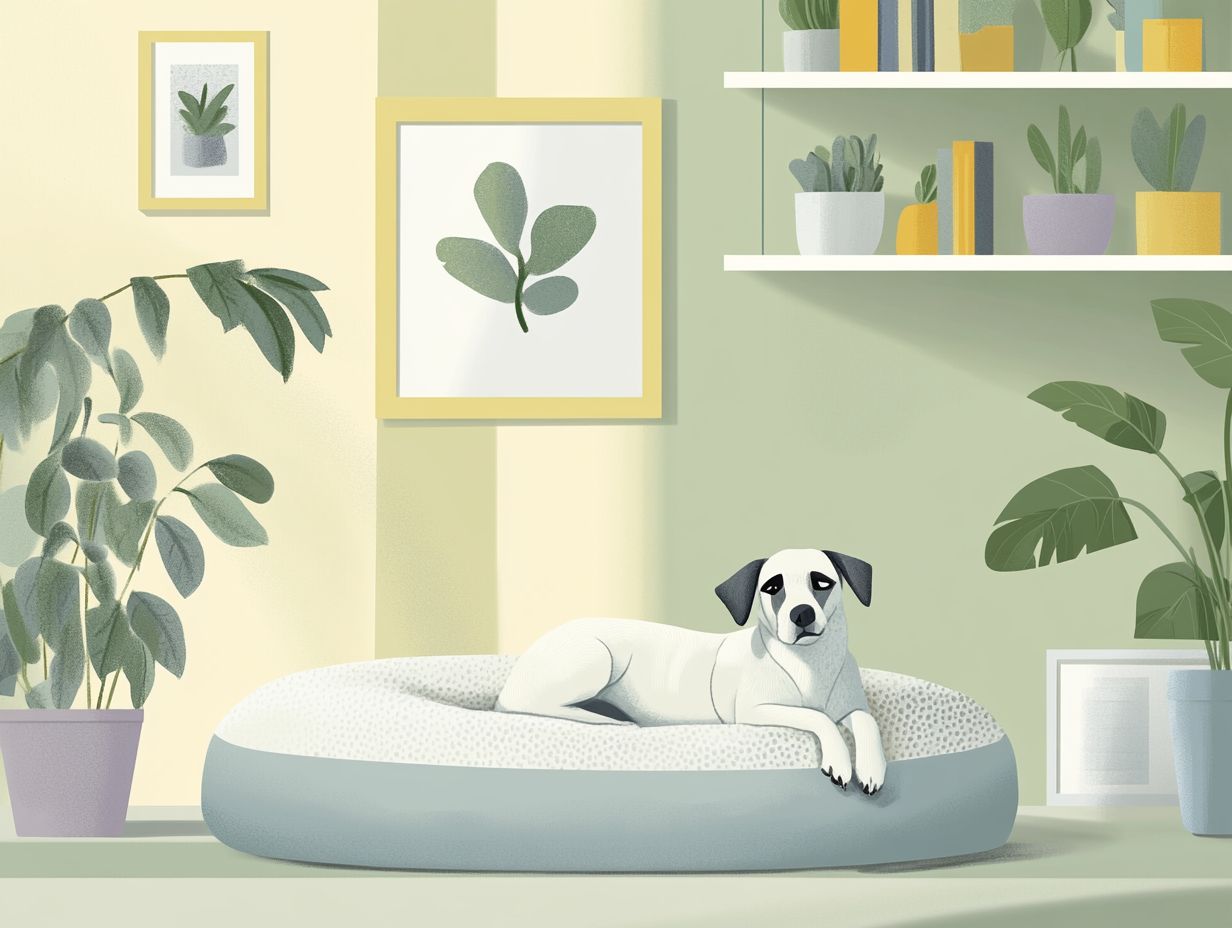
Creating a serene space for your pet requires a careful choice of colors and materials. Each choice contributes to an atmosphere of tranquility and emotional well-being.
By thoughtfully selecting hues that resonate positively with your pet and integrating elements that nurture a sense of comfort, you can markedly elevate their quality of life. This carefully curated environment becomes instrumental in alleviating anxiety and fostering positive behaviors.
Transform their daily experience into one of peace and contentment!
Incorporating Color into the Environment
Incorporating color into your pet’s environment is a delightful endeavor! You can achieve this through various elements like walls, furnishings, and accessories, all working together to create a serene atmosphere.
By thoughtfully selecting hues that promote calmness think soft blues, greens, or neutrals you can transform the spaces designated for your furry companions. For example, painting an accent wall in a gentle shade or choosing pet-friendly furniture that complements the overall color palette will foster a sense of tranquility.
Accessories, such as cozy blankets and toys, can reflect color preferences for animals, providing both comfort and style! Engaging toys also provide the perfect opportunity to introduce these soothing colors.
It’s crucial to maintain cleanliness in these areas. Clutter, dirt, and overall cleanliness can disrupt the tranquil ambiance you ve worked so hard to create. Regularly wash textiles and opt for materials that are easy to clean. This will not only keep the environment looking appealing but will also enhance your pet’s comfort and overall well-being.
Tips for Maintaining a Calming Color Palette
Maintaining a calming color palette, based on the Babin study, highlights the importance of color choices in your pet’s environment. Consistent attention to detail and a steadfast commitment to nurturing the emotional benefits linked to your selected colors are essential.
It’s about creating a serene space that contributes to your pet’s well-being! Ensure that every hue resonates with tranquility and comfort for both pets and their caregivers.
Practical Considerations and Maintenance
When maintaining a calming color palette, practicality and freshness are essential. Select durable materials that can withstand the playful nature of dogs and cats.
Think about the psychological effects of color. Soft, neutral tones like light blues, greens, and grays evoke tranquility, making them perfect for a serene atmosphere.
These shades cleverly disguise minor stains and pet hair, helping to keep your space looking fresh and inviting. If you want to use bolder colors, consider adding them in accents like throw pillows or decorative elements.
Choosing pet-friendly fabrics and finishes, along with a thoughtfully curated color scheme, can beautifully blend aesthetics with practicality. This creates a welcoming environment for both your pets and yourself.
Frequently Asked Questions
1. How do I select a calming color palette for my pets?
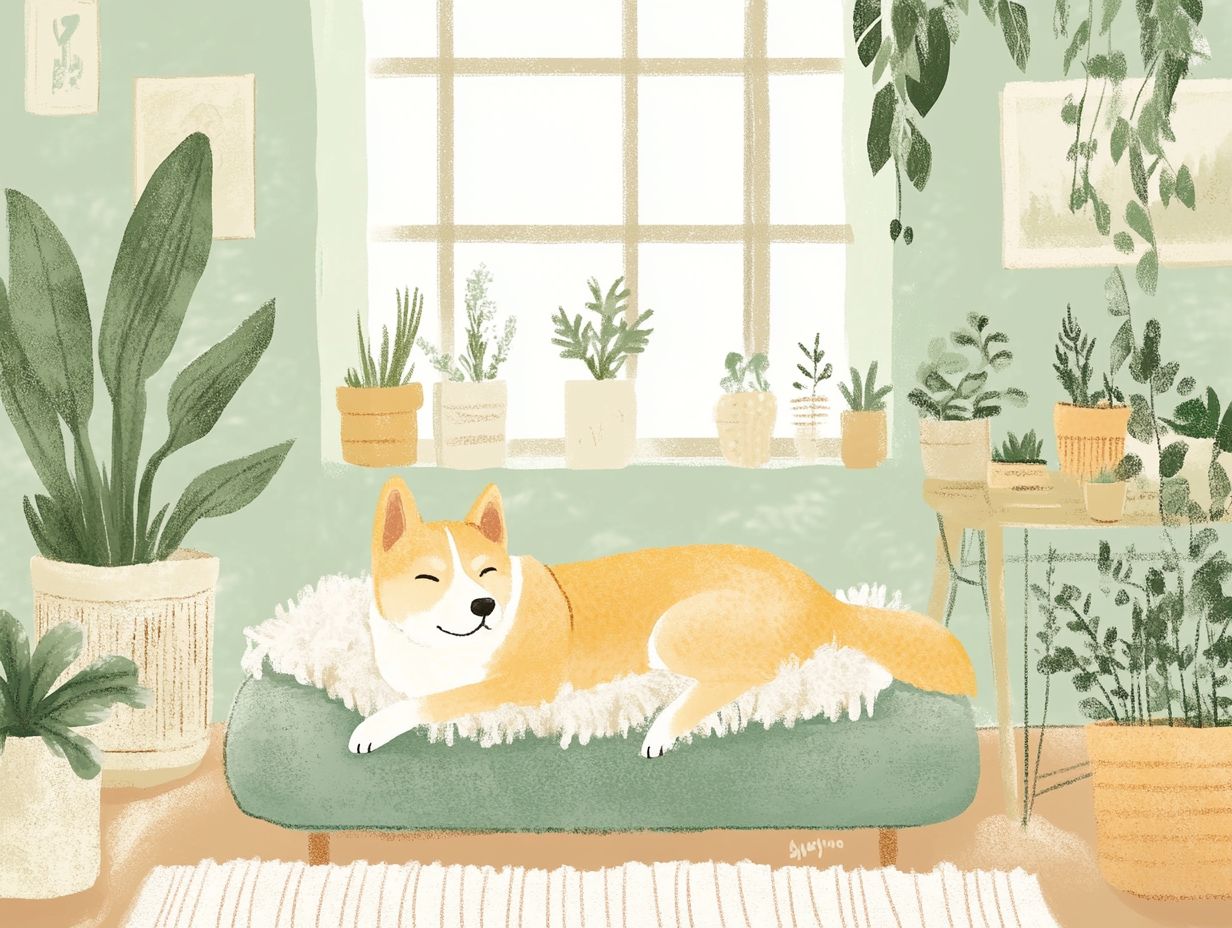
To select a calming color palette for your pets, consider their species, personality, and behavior. Different colors can affect pets differently, so choose colors that promote calmness. Additionally, exploring how to use textures to calm anxious pets can further enhance their comfort.
2. What are some examples of calming colors for pets?
Calming colors for pets include light blues, greens, and lavenders. These colors reduce anxiety and stress in both humans and animals.
3. How can I incorporate calming colors into my pet’s environment?
Incorporate calming colors in your pet’s bedding, toys, and accessories. You can also paint their living space or add decorative elements to create a soothing atmosphere.
4. Can certain colors have a negative effect on pets?
Yes, bright colors like red and orange can be overstimulating, possibly causing anxiety or hyperactivity. It’s best to stick to calming colors for your pet’s wellbeing.
5. How can I tell if my pet is reacting positively to a calming color palette?
Observe your pet’s behavior when exposed to calming colors. Signs of a positive reaction may include relaxation and improved sleep patterns.
6. Are there any additional ways to create a calming environment for my pets?
To create a calming environment, incorporate natural elements like plants and natural lighting. Playing soothing music and providing comfortable spaces is also important.

